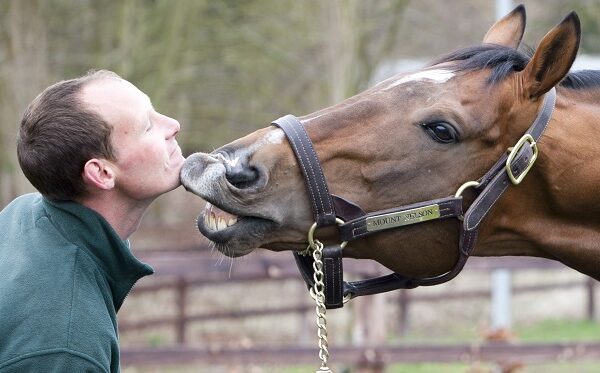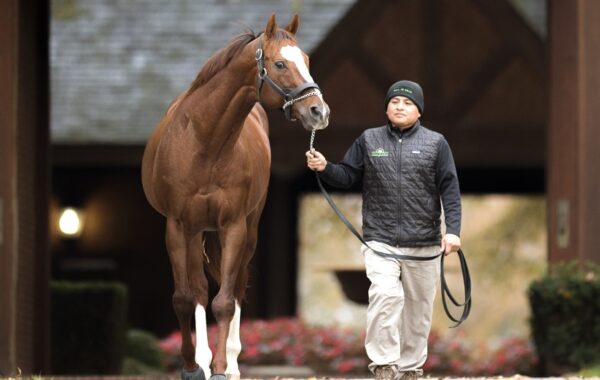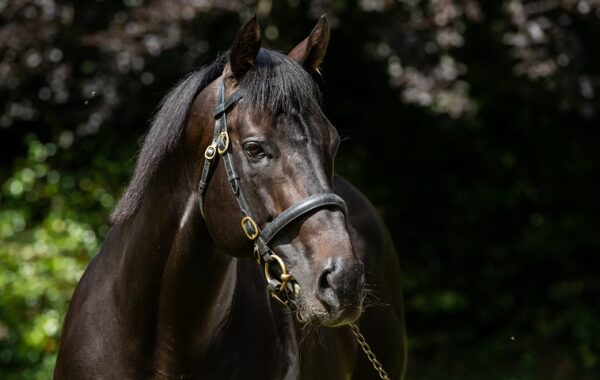Nearly five years ago in this column I raised the possibility that the gap between the French breeding industry and its British and Irish counterparts was about to narrow.
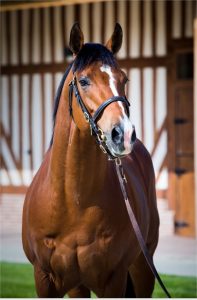
Olympic Glory covered 160 mares at Haras de Bouquetot
A variety of evidence suggests that this possibility is now coming to fruition. For example, when Siyouni’s fee for 2018 was set at €75,000, he became the highest-priced stallion ever to stand in France (the previous high belonged to the Australian shuttler Redoute’s Choice, at €70,000 in 2013). Then there’s the impressive number of high-class performers which are covering their first mares in France in 2018. France has had the support of some free-spending members of the Al Thani family from Qatar, with Sheikh Joaan basing his operation at Haras de Bouquetot. Bouquetot figures prominently among the studs with new stallions, having added the Group 1 winners Al Wukair, Brametot, Ectot, Toronado and Zelzal to its team.
French studs have also added the 2017 Derby winner Wings Of Eagles and 2016’s outstanding middle-distance three-year-old Almanzor, while the Aga Khan’s stallion team has been boosted by Zarak, a Group 1 winner sired by the exceptional Dubawi from the brilliant Zarkava. For good measure, other newcomers to France include The Grey Gatsby (Prix du Jockey-Club and Irish Champion Stakes), Ultra (Prix Jean-Luc Lagardere) and Recorder (a Group-winning two-year-old by Galileo).
Thanks to statistics which appeared in Jour de Galop, it also appears that French stallions in general are producing more foals. Back in 2013 only four French stallions covered 150 mares or more, with another 17 covering books of between 100 and 149. By 2015 the respective totals had risen to nine and 24, with the 2016 score being six and 31. The provisional figures for 2017 stand at six and 29. These figures cover the Flat and jumping sectors of the French breeding industry.
The busiest stallion in 2017 was the up-and-coming Dabirsim, who attracted 198 mares. This champion two-year-old certainly isn’t going to be short of ammunition in years to come
Busy boys
The busiest stallion in 2017 was the up-and-coming Dabirsim, who attracted 198 mares. This champion two-year-old certainly isn’t going to be short of ammunition in years to come, though he has only 64 two-year-olds this year from his second German crop, sired at Gestut Karlshof before his move to Haras de Grandcamp. He covered 161 mares in 2016, following his move to France, and he is also heavily oversubscribed in 2018, even though his fee has been raised from €9,000 to €30,000. That substantial rise reflects his feat of taking the title of France’s champion first-crop sire.
Next on the list comes Siyouni. Here is another stallion whose career looks sure to keep following its upwards trajectory. Although all of his racing-age progeny in 2017 were produced at a fee of only €7,000, that didn’t stop him supplying performers of the calibre of Laurens, Le Brivido, Siyoushake and Sacred Life. In addition to taking the two-year-old sires’ championship, his fourth place behind Nathaniel, Galileo and Sea The Stars on France’s general sires’ table made him the most successful French-based stallion.
Needless to say, Siyouni’s fee and crop size have undergone substantial increases since his bright start in 2014. He covered 190 mares at €20,000 in 2015, 224 at €30,000 in 2016 and 191 at €45,000 in 2017. It will be interesting to see how many mares he is asked to cover now that he is priced at €75,000.
The argument used to be that there weren’t enough high-class mares in France to support very high-priced stallions but Siyouni now has plenty of supporters in Britain and Ireland. More than 80 of his 2017 foals were foaled on the British and Irish side of the Channel, with two of them bred by The Queen.
The other Flat stallions who covered more than 150 mares in 2017 were Olympic Glory (160), Shalaa (158 mares in his first year) and Le Havre (155). Of course, Le Havre is another whose fortunes have been rising thanks to an eye-catching start with five crops sired at fees of €7,000 or less.
Intello appears to have been given a warm welcome back to France, covering 128 mares in 2016 and 147 in 2017
He covered 199 mares at €20,000 in 2015 and 189 at €30,000 in 2016. The drop to 155 mares last year coincided with his fee being raised to €60,000. British and Irish breeders who urgently need outcrosses will be hoping that Le Havre continues to thrive, and Dabirsim.
Intello’s big year
The 2018 racing season is going to be a fascinating one for admirers of Intello, the 2013 Prix du Jockey-Club winner who was distinctly unlucky not to have also won the Poule d’Essai des Poulains. Bred on the same Galileo-Danehill cross as Frankel, Teofilo, Noble Mission and Highland Reel, Intello is now back at Cheveley Park Stud, where he began his stallion career in 2014 and 2015, before moving – as arranged – to Haras du Quesnay for the next two seasons. He appears to have been given a warm welcome back to France, covering 128 mares in 2016 and 147 in 2017.
As might be expected of a Galileo colt trained by the patient Andre Fabre, Intello improved considerably from two to three, to the extent that Timeform rated him 129. Consequently, it is fair to expect Intello’s first crop to make a much bigger impact as three-year-olds in 2018.Some of Intello’s first two-year-olds hinted at what might be to come, with Sonjeu winning three of her five starts, including the Listed Prix Saraca, while Louis d’Or was second to Wind Chimes in the Listed Prix Herod. The best of his English representatives was Gabr, a creditable fifth in a hot-looking Racing Post Trophy.
Another young French stallion with numbers on his side is Rajsaman, who followed the example of his stud companion Le Havre and Siyouni by siring a Classic winner in his first crop, thanks to the Poule d’Essai des Poulains and Prix du Jockey-Club successes of Brametot.
Rajsaman was France’s busiest stallion in 2015, when he covered 219 mares, and his tally for the next two years stood at 189 and 144. Although this son of Linamix now stands at double his initial fee, he still costs no more than €8,000.
Following Martaline’s Path
The busiest stallions’ list also produced a new leader in the jumping sector, with Halling’s smart stayer Coastal Path notching up 165 mares at a fee of €3,000.
Part of this handsome horse’s appeal is that he shares the same dam, Coraline, as Martaline, who gained a well-deserved first sires’ championship in 2017. However, Coastal Path has also earned his growing popularity by siring several talented youngsters, headed by Bacardys, a dual Grade 1 winner over hurdles in Ireland. Coastal Path also covered 125 mares in 2016 and 99 in 2014, so he will have enough runners to make a big impact.
Coastal Path was bred and raced by Juddmonte and so was Spanish Moon, the Grand Prix de Saint-Cloud winner who ranks second among the busiest jumping stallions, with 145 mares. The son of El Prado has already had a few promising representatives in Britain and Ireland, including the Grade 3 hurdles winner Laurina, the Grade 2-placed Crack Mome and Listed bumper winner Daphne du Clos, and there will be plenty more like them in future years.
The Montjeu factor
Montjeu’s Group 1-winning son Montmartre remains popular, his totals over the last three years standing at 165 in 2015, 154 in 2016 and 131 last year. Already well known thanks to the exploits of such as Petite Parisienne, Labaik, Capitaine, Bigmartre and Kalkir, Montmartre seems very well placed to further Montjeu’s influence in the National Hunt world.
And so does Joshua Tree, a three-time winner of the Grade 1 Canadian International based at Haras du Grand Courgeon. This Group winner at the ages of two, three, five and six covered only 47 mares in his first season in 2015 but has since covered books of 110 and 131 mares, which suggests that breeders have been impressed by his youngsters.
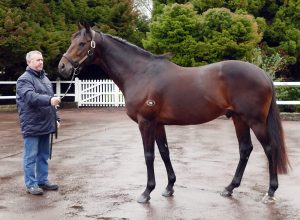
St Leger winner Masked Marvel stands at Haras d’Etreham
The third son of Montjeu riding high on the 2017 list is Masked Marvel, the 2011 St Leger winner who returned to Europe after failing to add to his reputation during a stint in Australia. He is based at Haras d’Etreham, a stud which has wielded a powerful influence on the jumping sector via the now-retired Poliglote and the now 20-year-old Saint Des Saints. Masked Marvel began with a book of 55 mares in 2015, but he is another who must be pleasing breeders, as his book rose to 91 mares in 2016 and then to 123 last year.
Jumps form respected
France owes its status as a first-rate source of jumping winners to a wide variety of stallions. In addition to using smart Flat performers the French have been happy to use entires which did well over jumps, such as Saint Des Saints, or sons of leading sires of jumpers.
The rush to geld the vast majority of potential jumping horses in Britain and Ireland means that this type of stallion has only rarely been available on this side of the Channel, but there are still several in France which attracted 100 or more mares in 2017. The busiest, with 130 mares, was 19-year-old Kapgarde. Also well known is Great Pretender, sire of Ptit Zig, Mr Mole and Great Field. This talented Flat performer by champion jumping sire King’s Theatre covered 100 mares in 2016 and 113 in 2017.
Among the less familiar names are Diamond Boy, Cokoriko, Jeu St Eloi and Choeur du Nord. Although Diamond Boy didn’t race over jumps, this 14-furlong Listed winner is proving popular as a son of Mansonnien, a stallion responsible for such smart jumping winners as Golden Silver, J’y Vole, Taranis and Mansony. Diamond Boy is another enjoying increasing demand, with his book going from 55 to 109 and 128 last year.
Keep an eye on Vision d’Etat. Already sire of De Bon Coeur, a dual Grade 1 winner over hurdles, Vision d’Etat covered 107 mares in 2017
Cokoriko was a Listed winner over hurdles at Auteuil during a brief career, and he has the added attraction of being a son of the good hurdler Robin Des Champs, sire of such standouts as Vautour, Sir Des Champs and Quevega. Based at Haras de Cercy, Cokoriko covered 111, 113 and 124 mares over the last three years.
Jeu St Eloi won over hurdles and fences at Auteuil, also the scene of his sire Saint Des Saints’ seven wins over hurdles. From the same family as the successful sire Balko, Jeu St Eloi covered 119 mares in his first season in 2016, followed by 110 in his second. Choeur du Nord, who won two of his three starts over hurdles, has a fine jumping pedigree. His sire Voix Du Nord has made his mark as the sire of such good jumpers as Vibrato Valtat, Taquin du Seuil, Bachasson and Defi du Seuil. Choeur du Nord’s dam is also the second dam of Cokoriko and he covered 73 and 101 mares in the last two years.
Also, keep an eye on Vision d’Etat. Although good enough to win the Prix du Jockey-Club and Prince of Wales’s Stakes, Vision d’Etat was always going to find it difficult, as a Flat sire, to overcome the fact that his dam Uberaba was a four-time winner over jumps. Already sire of De Bon Coeur, a dual Grade 1 winner over hurdles, Vision d’Etat covered 107 mares in 2017.



